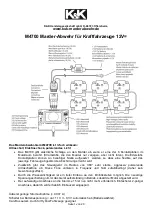
Handbook for the SX remote control Spectrograph Issue 1, 17/8/20
Quick starting your spectrograph setup:
NB. Your spectrograph contains a delicate replica grating, which is easily damaged by contact with other surfaces,
including fingers and cleaning cloths. Avoid coming into contact with this part and keep it free of dust by keeping the
spectrograph cover in place when not adjusting the coarse focus. Small dust particles may be removed with an air
canon or a soft brush.
First, you need to install the control software ‘SXspectrum’ from the supplied memory stick. Plug in the stick and locate the
SXspectrum folder. In the sub folder ‘publish’ find ‘Setup.exe’ and run it. You may get warnings about an ‘Unknown Pub-
lisher’ but bypass these and permit the application to install. You should now have a new icon on the desktop which displays
a spectrum with the letters ‘SX’ superimposed.
Plug in the USB cable to the spectrograph and follow this with the 12v supply plug. There will be a short burst of ‘clicks’
from the spectrograph as it calibrates the slit wheel position. A menu for the software will also appear and will request you
to identify the serial port number to be used by the spectrograph. If more than one COM port is offered, it is usually correct
to select the one with the highest number. If the port is correct, the software will activate and will show successful TX and
RX values in the bottom info. strip.
The spectrograph is automatically started with the slit set to the highest resolution position (Number 1, 20 microns wide x 1
mm high). This is usually the best setting for general purpose use, but may be changed by selecting another option on the
‘radio buttons’ at the left side of the software menu.
The initial adjustments are most easily made with the spectrograph removed from the telescope. First, set the fine focus ring
at around mid-travel, so that adjustment may be made in either direction. Now attach your camera to the T2 adaptor and
remove the 6 thumbscrews from the top cover, so that the cover may be lifted for access to the focus lock screw. Slightly
loosen this screw, using a 2 mm hexagon key (supplied), and set the camera orientation so that the long axis of the CCD is
horizontal. Drop the cover back into place, but do not screw it down yet. You can now observe the calibrator spectrum to
optimise the focus and orientation.
Cover the front aperture of the spectrograph and switch on the Ref light. Boot up the camera and capture a 1 second expo-
sure of the spectrum. It will probably be somewhat tilted and out of focus - slide and rotate the camera to optimise the image
quality and position. When satisfied, lift the spectrograph cover and tighten the focus lock screw. Re-fit the cover and
screws to complete this operation. Do not leave the reference light on for long periods, as this can cause darkening of the
glass tube and dim the light.
If the focus is accurate, then you are ready to use the spectrograph on your telescope, but, if necessary, you can refine the


































